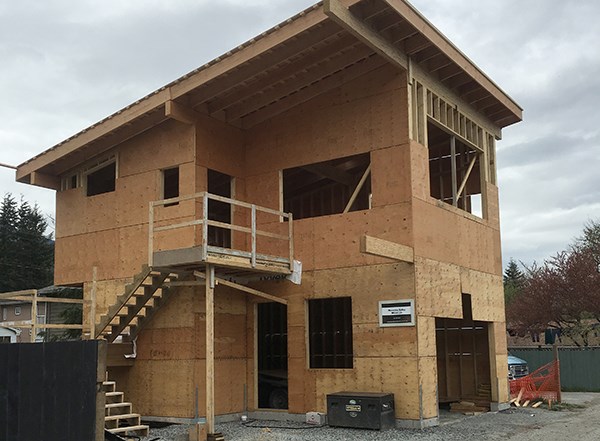It will take some adjustment, but Susan Chapelle and her family are excited to move into their new coach house in Squamish as soon as construction is complete.
The 600-square-foot, self-contained house is being built behind their family home in downtown Squamish and, once it’s finished, Chapelle will rent out the main house.
“Not everyone in the world has as much space as we do, so it’s definitely manageable,” she said, comparing the close quarters to living on a boat, with compact features built into the design. Her two daughters, for example, will share a room now and move from twin to single beds to save space.
Like several other homeowners in Squamish, Chapelle is opting for a coach house (also known as a granny flat, laneway or carriage housing) instead of a suite.
To save money, Chapelle, who is a District of Squamish councillor and registered massage therapist, is able to build much of the laneway house herself due to her experience as a stagehand who specialized in electrical work and carpentry for theatre, as well as working as steel rigger in large arenas.
She is using recycled materials to make the house environmentally friendly.
“The only way to afford it, and pay it off, is to live in it,” she said, estimating that building a coach house costs nearly the same amount as a normal-sized house.
At 600 square feet, the living area is as large as it’s allowed to be according to district bylaws, which in floodplain areas also restrict the bottom floor to a garage or space for certain kinds of storage, such as for recreational equipment.
The entire structure must be less than 1,249 square feet, and one off-street parking spot needs to be available.
Unlike other municipalities, such as North Vancouver, which has a bylaw that coach houses must mirror the style of the main house, the District of Squamish doesn’t have rules on outside aesthetics. This freedom lets homeowners decide which style of architecture they would like.
In the past three years, 14 building permits have been issued for coach houses in Squamish, but it often takes a few years for construction to begin.
“We’re encouraging laneway housing to diversify the housing stock and provide more price options for the community,” said Mayor Patricia Heintzman.
Coach houses give families additional options on where to live, although they typically rent for more than apartment suites. With rental prices increasing in Squamish, Heintzman wants coach houses to be rented long-term to residents, rather than temporarily to overnight travellers through websites such as Airbnb.
Garrett Gosselin predicts he will be able to rent his Valleycliffe coach house for $1,800 a month once it’s complete.
He had a custom design drafted and is doing most of the construction himself during his downtime from running a limousine service. “Because it’s so small, I can afford to put in nice finishes, like granite countertops, and not have to spend a fortune,” said Gosselin, who estimates the coach house will cost him between $80,000 and $100,000 to build but says the cost would go up significantly if he hired someone else to do the work. The house will be in the West Coast style with timber beams on the deck and a fireplace in the living room.
“We’re used to having a lot of land here in Squamish, but land is getting expensive so we might as well use it for a useful purpose.”



